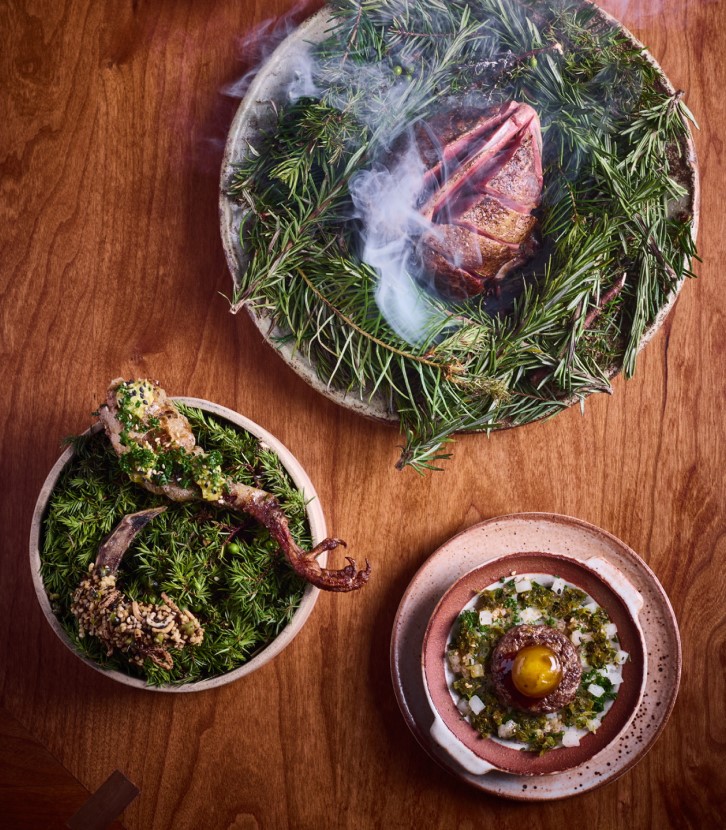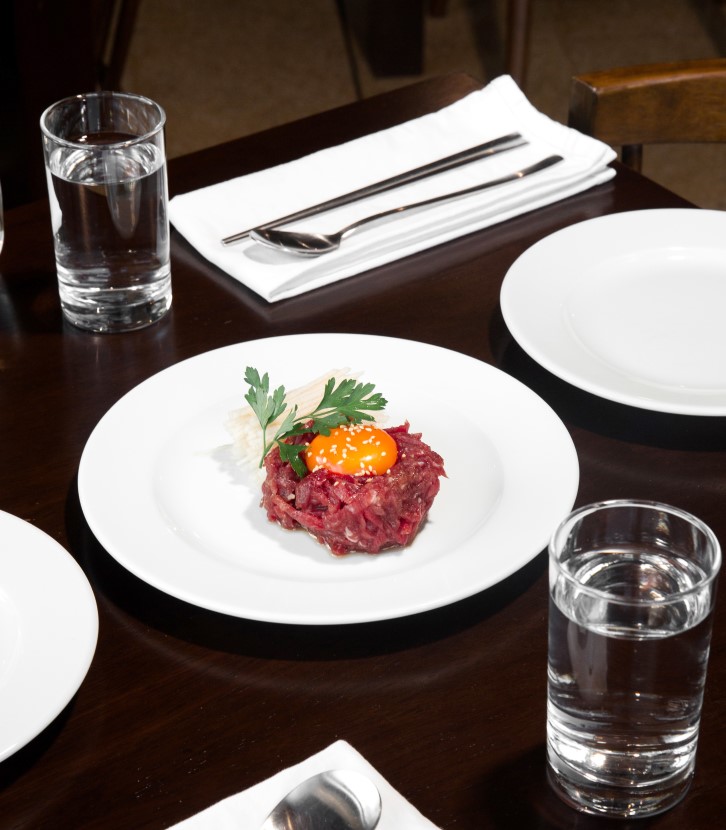Kent may be situated right next to London, with many of its most attractive spots within an hour of the capital, but it feels worlds away. With its serene countryside, scenic coastline, quietly stylish towns and a food scene that punches well above its weight, the county offers a little bit of everything, without the crowds or the fuss. Join us on a MICHELIN Guide rundown of the best reasons to visit Kent this summer.

Chalk, Trails and Countryside Views
Kent has a natural beauty that is at times local and cosy, but at others plays out on a cinematic scale, from towering chalk cliffs to ancient woodlands and unreal trails. Most iconic of all are the White Cliffs of Dover, formed over millions of years from compressed ancient sea life. On a clear day, you can spot the coast of France shimmering across the Channel. Just along the coast, St Margaret’s Bay marks the closest point between England and France.
Inland, the Kent Downs National Landscape unfurls in soft hills, grasslands and ancient orchards. The North Downs Way, a pilgrimage path turned long-distance trail, winds through it all, past hilltop churches, Saxon ruins and wildflower-strewn woodlands. It is a gentle but rewarding route, where each bend in the path opens up to panoramic views that stretch across the High Weald and beyond.
Further west, Bedgebury National Pinetum and Forest offers a change of pace, with its soaring redwoods and rare conifers lending an idyllic feel to this pocket of Kent. There are miles of cycling and walking trails, as well as tree-top adventures and lakeside paths. It’s the kind of place that quietly captures your attention, wild in parts, curated in others and beautiful all year round.

From Castle Grounds to Secret Gardens
There’s a reason Kent is known as the ‘Garden of England’. It’s a county filled to the brim with both wild country landscapes and beautifully kept gardens. At the heart of it all lies Sissinghurst Castle Garden, a serene 20th-century masterpiece shaped by writer and horticulturist Vita Sackville-West. Designed as a series of ‘garden rooms’, each outdoor space offers its own mood and palette, from romantic whites to fiery reds. The castle’s iconic tower rises above it all, offering sweeping views of the surrounding countryside and the distinctive oasthouses (used for drying hops) that dot the landscape, typical of Kent’s agricultural heritage.Nearby, Leeds Castle stands in stately contrast, its centuries-old beauty framed by 500 acres of greenery and wild parkland. Black swans drift across the moat, while seasonal colour sweeps through the Wood Garden and the Mediterranean-inspired Lady Baillie Garden. Its legacy as a regal residence is felt throughout the estate, which also offers a glimpse into the past through its well-preserved gardens and seasonal plantings.

Chartwell, Winston Churchill’s former home, offers a more grounded take on stately living. The gardens showcase the personal touch of both he and his wife, Clementine, from the structured kitchen garden he helped plant to the rose beds that soften the landscape. Chartwell captures Churchill not as an icon, but as a man at home – reflective, rooted and surprisingly hands-on.
For those looking to step off the main trail, Hole Park Gardens offers a more private kind of beauty. Independently owned and tended to by the Barham family, it’s a cultivated 200-acre sprawl of clipped hedges, wild pockets and long views over the Kentish Weald. Hever Castle, meanwhile, stands out for its gardens as much as its Tudor past. The Italian Garden, built by William Waldorf Astor to house his classical sculptures, is structured and dramatic, while the Sunken Garden, slightly off the main path, rewards those who wander a little further.

The Local Side of the Garden of England
If Kent’s gardens and estates provide historical drama, then its towns and villages are where the region softens at the edges. Here, afternoons are for unhurried wanders, heritage trails and long chats with friendly locals over pints of something brewed just down the road.Take Tenterden, for instance, a town that feels like it has had the dust of time gently brushed off it. Locals call it the Jewel of the Weald, but there’s nothing showy about it. The high street is wide and tree-lined, with a patchwork of timbered buildings, small galleries and quiet bookshops. On Saturdays, you might hear the low whistle of the Kent and East Sussex Railway echoing across the valley as a vintage steam train trundles past, its carriages full of day-trippers and trainspotters.
A little further north, Biddenden delivers country life with a certain finesse. The village greenery is flanked by Tudor-style houses and everything from apple orchards to vineyards are within walking distance. It is a place of local lore, with the tale of the Biddenden Maids woven into everything from road signs to biscuit tins. If you’re in need of refreshment during your visit, look no further than The West House, a cosy restaurant in a 15th-century weaver’s cottage, run by rock-drummer-turned-chef Graham Garrett.

For something slightly larger but still local-feeling, Canterbury is Kent’s most famous city, renowned for its UNESCO World Heritage Site cathedral. A place that wears its history like layers, Canterbury’s centre is grand and gothic, with the soaring cathedral pulling focus, spilling out into streets that feel made for meandering: narrow, cobbled and full of surprises. You’ll find Roman ruins tucked behind modern boutiques, and riverside paths that invite you to pause and watch the punts glide past.

Coastal Gems and Super-Fresh Seafood
At the core of Kent’s charm is its variety. Those looking for a countryside escape can easily find it, but families in search of a classic British seaside getaway will be equally satisfied. On the south coast there’s Hastings and Dungeness, to the east Broadstairs and Margate. The latter is a particularly good spot for foodies, with Sargasso, Sète, Angela’s and family-run Italian Bottega Caruso to choose from.Around 30 minutes away, Whitstable provides another love letter to the English seaside. Drift between the beach huts and oyster shells, browse the Harbour Market for hand-thrown ceramics and sea glass jewellery, and follow the coastal path to Tankerton, where the crowds thin and the horizon opens up. It’s not trying to impress. It just does.
Seafood enthusiasts will find their paradise at the Whitstable Oyster Company, an institution at the heart of the town’s maritime heritage. Serving up the famous Whitstable oysters grown right outside the restaurant, the family-run business celebrates beautiful local seafood in dishes that are deliciously simple. Dining here, with the theatrical coastline as a backdrop, offers an unparalleled opportunity to experience the very soul of Kent’s coastal bounty.

From Soil to Cellar and From Farm to Table
Kent’s food and drink culture goes well beyond the plate, with a bounty of produce grown right here on its restaurants’ doorsteps. Chefs in Kent are rightly proud of their region; whether you prefer a formal establishment or a welcoming pub, you’ll find Kent ingredients on show. What’s more, it’s one of the very few places in the UK that can say it offers locally produced wines.At The Sportsman, near Seasalter, the hyper-local, high-quality ingredients are key to its philosophy. With its MICHELIN Star firmly in place since 2008, this top-drawer dining pub is renowned for its consistently impressive cooking that revolves around the local area. The menu changes seasonally, but the constant is a culinary style that is complex yet never showy, with high-level technique used only in the service of flavour. Classic combinations like pork and apple are executed in enormously satisfying ways.

Kent’s produce is once again the focus at Boys Hall, which combines history with hospitality. This 17th-century house, lovingly restored, offers locally driven food that forms part of a magnificent overall package. Parts of the original house are now guest bedrooms, while the well-kept gardens are ideal for a post-lunch stroll and there’s even an on-site pub and terrace – meaning you can sit back with a pint, take a deep breath and let the relaxation wash over you.
For those searching for a true taste of Kent’s winemaking heritage, Swan Wine Kitchen is a must-visit. Nestled in the heart of the picturesque Chapel Down vineyard, the restaurant offers quality produce on a daily changing menu, which is all best enjoyed with a glass of one of their own wines. English vineyards are often looked down upon, but dining here might just change your mind. The far-reaching views of the vines certainly enhance the experience, too.

Premium Pubs for the Weary Traveller
As an area with such pride in its produce, it’s no surprise that Kent is one of the best places for finding proper country pubs with outstanding food. Alongside The Sportsman, two more pubs hold a MICHELIN Star for their cooking, while retaining a welcoming pubby atmosphere. Both are located just a short drive from Canterbury, making them ideal if you’re using the cathedral city as your base.In Fordwich, England’s smallest town and a charmingly quaint spot, The Fordwich Arms has built a loyal following over the years. Its location alongside the River Stour is picture-perfect and the cooking is no less impressive, taking superb ingredients and allowing them to shine in thoughtful combinations with the odd creative touch.
In a similar vein, The Bridge Arms is just down the road and offers elevated pub dining in a lovely 16th-century setting. The menu honours tradition while introducing modern elements in an accessible and enjoyable way. The kitchen’s strong technical skill is most evident in the sauces, which offer wonderful depth of flavour.

Where to Stay in Kent
To explore even a fraction of what Kent has to offer, you’ll need a good base – for which you can turn to The MICHELIN Guide’s hotel selection. The county’s best stays favour substance over spectacle, with detail-driven design and a deep-rooted feel. In Margate, Fort Road Hotel is a grown-up revival of a coastal classic, with modern interiors and expansive views out to sea. With the Turner Contemporary gallery close by, art is key to its appeal, with the hotel displaying works from Tracey Emin, a Margate local.Over in Sandwich, The Bell Hotel pairs its 19th-century bones with stylish, contemporary rooms and a leisurely riverside setting. The bright, airy interiors are well-suited to a summer getaway. In Deal, The Rose offers bold colours, mid-century details and a location that puts the beach and town centre just a short stroll away. It was once just a local pub, but now feels like it was born to be a boutique hotel.
You won’t see all of Kent in one trip, and that’s exactly its appeal. Kent isn’t made for box-ticking, but for returning to again and again. Within it, you’ll find breathtaking views, sublime hospitality and little pockets that will linger in your mind long after you’ve gone, often in ways you don’t expect.
Hero Image: Leeds Castle, one of the best places to visit during a summer holiday in Kent. © asmithers/iStock


















